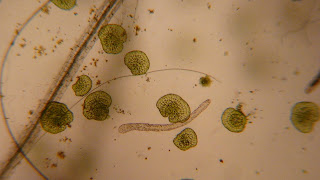
It sees that I am continuously noticing less activity and fewer numbers of organisms in my microaquarium, but I do observe new organisms almost everytime. I saw a different type of analid besides the Chaetogaster Ananlids. I discovered that I also had Stylaria Analids as well. I referenced Guide to Microlife. This organisms was continuously eating and moving around slow as it was searching for food. It had a long body divided into segments. Each segment had bristles. Also, it had a trunklike appendage which Dr. McFarland noted as a probuscis. I had noteable much more algae in my microaquarium everywhere. It seems that when I first observed in my aquarium I hardly had any, but now it is everywhere. I continued to see many of the other regular organisms that i had noted every observation. However upon seeing them I only noted differently that their numbers were dropping. This particular day I viewed the bottom of my microaquarium to observe what I could see. I saw many different dead organisms including the cyclops that was so hard for me to observe due to its rapid movements. I noticed ciliates feeding off of the dead organisms.
